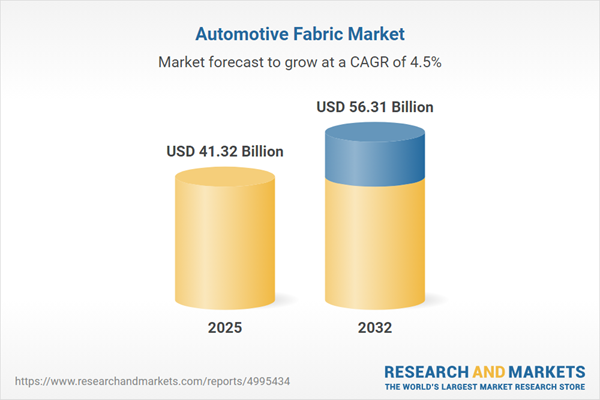Speak directly to the analyst to clarify any post sales queries you may have.
The Automotive Fabric Market is experiencing accelerated transformation, driven by the imperative for sustainable materials, advanced technologies, and shifts in consumer preferences shaping future in-cabin experiences.
Market Snapshot: Automotive Fabric Market Size and Growth
The Automotive Fabric Market grew from USD 39.54 billion in 2024 to USD 41.32 billion in 2025. It is expected to continue expanding at a CAGR of 4.51%, reaching USD 56.31 billion by 2032. This progression reflects growing integration of eco-friendly textiles, rising demand for comfort and performance, and evolving regulatory requirements globally.
Scope & Segmentation: Exploring Applications, Technologies, and Regional Trends
- Material Types: Coated fabrics, composites, knitted textiles, nonwovens, and woven materials each serve different design and performance needs.
- Applications: Key uses include acoustic insulation, carpets, door panels, headliners, safety features, and both front and rear seat systems.
- Distribution Channels: Serves both OEM integration and aftermarket customization or refurbishment markets.
- Vehicle Types: The spectrum covers commercial vehicles—such as fleet models requiring high durability—and passenger cars, often prioritizing premium finishes and comfort.
- Regions: Includes operations and demand across North America, Latin America, Europe, the Middle East, Africa, and Asia Pacific, each characterized by unique economic and regulatory factors.
- Key Companies: Major players include Freudenberg Performance Materials SE & Co. KG, Toray Industries, Inc., Lear Corporation, Adient plc, Toyota Boshoku Corporation, Grupo Antolin-Irausa, S.A., Trelleborg AB, Asahi Kasei Corporation, Banswara Syntex Limited, and Kusumgar Limited.
- Technologies: The landscape includes digital textile printing, nanocoatings, composites, smart textiles, and recycled or bio-based fiber manufacturing.
Key Takeaways: Strategic Insights for Automotive Fabric Industry Leaders
- Material innovation aligns with increased expectations for acoustic, safety, and lightweight performance, directly affecting product roadmaps.
- Digitization and smart textile integration are enabling new in-cabin functionalities, supporting personalization and elevated passenger experiences.
- Sustainability regulations in core markets are steering supply chains toward recycled and bio-based constituents.
- Consumer preferences are shifting to luxury and customization, reflected in demand for tactile comfort and versatile design options.
- Regional variations require tailored approaches, as economic drivers in Asia Pacific, Europe, and the Americas differ significantly in their influence on market dynamics.
Tariff Impact: Addressing 2025 United States Tariff Shifts
The introduction of 2025 US tariffs is prompting suppliers to reconsider global sourcing, fostering strategies such as nearshoring, flexible contracts, and local stockpiling of materials. These developments are shortening supply chains, boosting domestic manufacturing, and spurring sector-wide collaboration to offset cost volatility. Leaders are leveraging these challenges by forming agile partnerships and investing in proprietary technologies, thereby reducing exposure to tariff risks.
Methodology & Data Sources
This analysis synthesizes insights from primary interviews with leading industry executives and secondary review of regulatory documents, patent filings, and company reports. Findings are validated via case studies in key production hubs, ensuring rigorous triangulation of both market drivers and operational challenges.
Why This Report Matters
- Enables rapid assessment of sector shifts affecting supply chain resilience, sustainability compliance, and product differentiation strategies.
- Equips decision-makers to align material sourcing, design, and regional market entry with upcoming regulatory and consumer trends.
Conclusion
Leaders in the automotive fabric market must anticipate material, technological, and regulatory changes to sustain competitiveness. Proactive adaptation will unlock opportunities for innovation and collaborative growth across global mobility interior solutions.
Additional Product Information:
- Purchase of this report includes 1 year online access with quarterly updates.
- This report can be updated on request. Please contact our Customer Experience team using the Ask a Question widget on our website.
Table of Contents
3. Executive Summary
4. Market Overview
7. Cumulative Impact of Artificial Intelligence 2025
List of Figures
Samples

LOADING...
Companies Mentioned
The key companies profiled in this Automotive Fabric market report include:- Freudenberg Performance Materials SE & Co. KG
- Toray Industries, Inc.
- Lear Corporation
- Adient plc
- Toyota Boshoku Corporation
- Grupo Antolin-Irausa, S.A.
- Trelleborg AB
- Asahi Kasei Corporation
- Banswara Syntex Limited
- Kusumgar Limited
Table Information
| Report Attribute | Details |
|---|---|
| No. of Pages | 183 |
| Published | October 2025 |
| Forecast Period | 2025 - 2032 |
| Estimated Market Value ( USD | $ 41.32 Billion |
| Forecasted Market Value ( USD | $ 56.31 Billion |
| Compound Annual Growth Rate | 4.5% |
| Regions Covered | Global |
| No. of Companies Mentioned | 11 |









